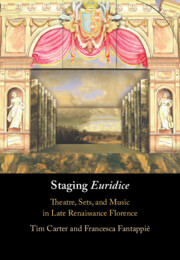Book contents
- Staging Euridice
- Staging Euridice
- Copyright page
- Contents
- Illustrations
- Tables
- Preface
- Sources, Transcriptions, and Translations
- Money, Accounts, Measurements, Dates, and Time
- Abbreviations
- 1 Euridice in Context
- 2 Staging and Sets
- 3 Euridice in Performance
- 4 Conclusions and Consequences
- Appendix I: Documents
- Works Cited
- Index
2 - Staging and Sets
Published online by Cambridge University Press: 11 November 2021
- Staging Euridice
- Staging Euridice
- Copyright page
- Contents
- Illustrations
- Tables
- Preface
- Sources, Transcriptions, and Translations
- Money, Accounts, Measurements, Dates, and Time
- Abbreviations
- 1 Euridice in Context
- 2 Staging and Sets
- 3 Euridice in Performance
- 4 Conclusions and Consequences
- Appendix I: Documents
- Works Cited
- Index
Summary
The stage and sets for Euridice were designed by the Florentine artist Lodovico Cardi, called “Il Cigoli.” His invoice survives, as do an inventory of their elements made when they were disassembled and put into storage, and a list of materials provided by the mattress maker, Francesco Ricoveri. These documents are remarkably precise, even with measurements, and they would permit an accurate reconstruction of the staging of the opera in the room in the Palazzo Pitti originally intended for it, the current Sala delle Nicchie (although it was eventually done in a different space later known as the Sala delle Commedie). Cigoli’s contribution renders problematic conventional views of any shift from “Renaissance” to “Baroque” scenography. The three main issues concern the design of the proscenium, how to render a proper perspectival view, and the most effective way to make set changes (Euridice moves from a pastoral scene to an Underworld one and back), whether by way of rotating “periaktoi,” sliding flats, or canvases pulled up and down. Our digital reconstructions make clear how things worked for the opera from the point of view of the stage itself, and as to what the audience saw.
Keywords
- Type
- Chapter
- Information
- Staging 'Euridice'Theatre, Sets, and Music in Late Renaissance Florence, pp. 64 - 129Publisher: Cambridge University PressPrint publication year: 2021



